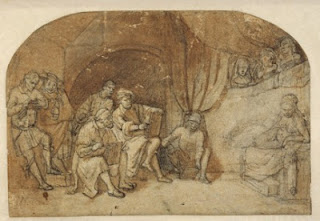Vincent Van Gogh,Self-Portrait, 1889, Image courtesy of the National Gallery of Art
Author Simon Schamaused this wonderful phrase about Vincent Van Gogh, in his book, "The Power of Art".Schama talked of Van Gogh seeking to create art that was imbued with the "visionary radiance" that previous generations of artists had found in Christianity. To achieve this source of light and inspiration that could reach out to fellow men, Van Gogh's approach was painting with "blood and blisters and staring until your eyes popped" (my emphasis).
Even though Van Gogh did not necessarily follow the time-honoured rules of perspective, colour usage or subject-matter, he sought to give his art a different, more open view of life that embraced nature in all its aspects. His pulsating interpretations of trees, fields, and flowers show powers of observation that amaze. Catching the clouds, the light, the motion of the wheat, or, in the Olive Grove below, the silvery dance and form of the olive trees - all that requires great, tenacious powers, first of observation, then of organisation and simplification.
Wheat Field with Cypresses, Van Gogh, 1889, Image courtesy of the Metropolitan Museum of Art
Olive Grove, Van Gogh, 1889
Every artist, especially those working with aspects of the world around him or her, knows that observation is key to understanding and thus depicting a subject. It does not necessarily have to be a realistic depiction either, just as in Van Gogh's case. Nonetheless, staring and staring at your subject always brings rewards; you keep noticing fresh aspects, you learn how things interlock, how things work, where the light falls, how shadows shape things. In this month's Artist's Magazine,for instance, in an article on still life artist Eric Wert, he is quoted as spending long hours "trying to get to the reality of a particular element. 'But once all the data are there that makes something look real,' he says, ' I step back and let it become its own creature, develop its own personality. I'm open to what the subject can start to tell me.' "
Another time one needs to stare, stare and stare some more is during life drawing. As soon as an artist begins to draw from a live model, the conversation begins between eyes, hand and the model. The subtleties of light on skin, the delicacy of muscles in tension or at rest, the twist of limbs or torso only reinforce the need to look and understand. Only with that understanding comes the freedom then to simplify, edit and create works that are powerful. Take but one example - Rembrandt:
Constantijn Daniel van Renesse,, Rembrandt and his Pupils drawing from a Nude Model. c. 1650, Image courtesy of Hessisches Landesmuseum, Darmstadt
Rembrandt, Study of Female Nude seen from the Back, 1630-34, Image courtesy of the Courtauld Institute, London
In other words, as the old English saying goes - "Open your peepers"! Your art will thank you.

















